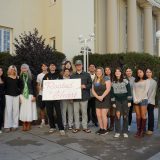Miya Ando’s Industrial Watercolors
August 21, 2015
Miya Ando, whose sculptural structure is now on view at the 56th Venice Biennale, is most well-known for the paintings she creates with metal. These “industrial watercolors” are made using a variety of complicated processes involving scorching heat, electrically charged vats, sharp tools, dangerous chemicals, loud sanding, and layers of paint or dye.
Her fascination with such a challenging material as metal stems from her family’s history as Bizen sword makers in Japan. She was raised around sword smiths and says she was “always in awe and fear of the powerful objects” they created. Furthermore, her dad was often welding car parts and other metal objects when she was around so she grew up feeling comfortable in a metal shop.
Ando’s pieces are meditative, reflective, and immersive. She transforms sheets of burnished steel or aluminum to get subtle gradations in color, so that her paintings often appear like abstracted scenes of still water or airy clouds. In this way, her work deals with opposites. The metal is heavy and tough and requires difficult work in order to tailor it to depict something light, elegant and peaceful.
As Ando explains, “I have a deep appreciation for the dynamic properties of metal and its ability to reflect light. Metal simultaneously conveys strength and permanence and yet in the same instant can appear delicate, fragile, luminous, soft, and ethereal. The medium becomes both a contradiction and juxtaposition for expressing notions of evanescence, including ideas such as the transitory and ephemeral nature of all things, and the underlying impermanence of everything.”
Some of the concepts tied into her art, like the one’s she mentions above, come from the Zen Buddhist ideas of nothingness and total absorption into one’s work. A few of Ando’s other family members were part of the Buddhist priesthood, therefore the ideas of Buddhism became a strong influence in Miya Ando’s life and on her work. As a viewer, we can meditate on one of Miya Ando’s “industrial watercolors” staring at the minimal variances in color and thinking about the beauty of life and the disappearance of all things.
This piece is part of Chapman University’s Escalette Collection, and is one of eight works included in our new exhibition, 1:1 — Pairings from the Escaeltte Collection of Art.
See it on view beginning September 1, 2015 in the Doy and Dee Henley Galleria, Argyros Forum second floor!





